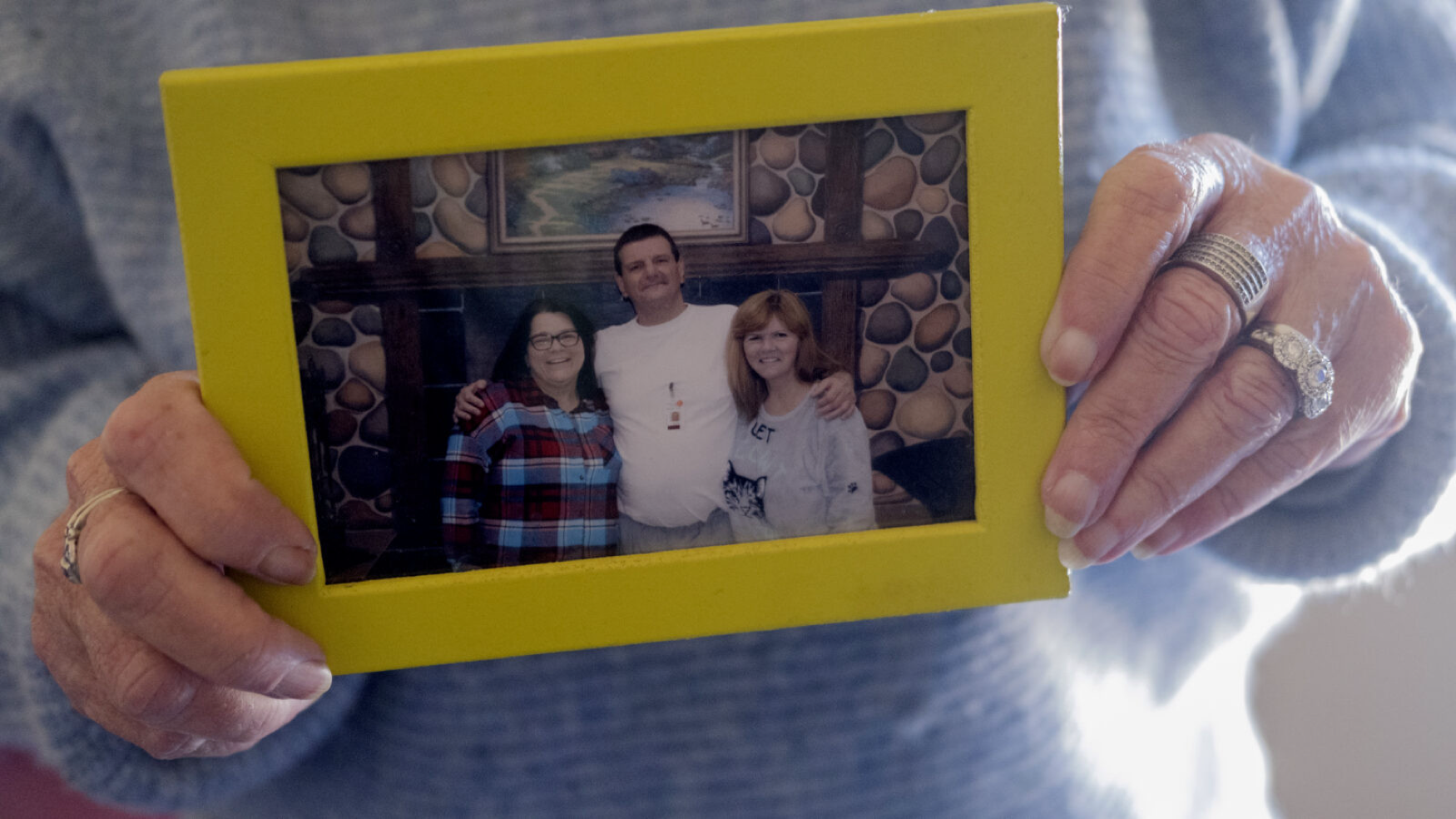BY NICHOLAS FLORKO
FALLS CITY, Neb. — John Ritchie shouldn’t have died.
He knew he had hepatitis C. And he knew, too, about the simple, once-daily pills that could fully cure him of the potentially deadly viral infection in about 12 weeks.
But Ritchie was serving a 20-year sentence for armed robbery, and the Missouri Department of Corrections refused to treat him.
Ritchie begged repeatedly for the medicine. He went through all the formal steps to request medical care. The prison system knew he was getting sicker and sicker — it documented his deteriorating condition in his health records. The prison’s doctors wrote frequently he would benefit from hepatitis C treatment. But officials still denied him, in the same way a STAT investigation documented prisons around the country are still denying thousands of others the cure.
So the virus infecting Ritchie’s blood continued to replicate, scarring his liver until it was so damaged that it could hardly function. Eventually he was diagnosed with liver cancer, a common complication of untreated hepatitis C. Now, the prison argued, he was too sick for the drugs to work. They refused him again.
“I don’t have the energy to do nothing anymore,” Ritchie told a court in 2019. “I try to talk too long, I can’t breathe … I get out and get a little fresh air, but I can’t do a lot of walking, and I can’t get in the sun.”
He died in June 2021 at the age of 64, nearly five years after his first request for medication.
STAT’s investigation found that 1,013 people died of hepatitis C-related complications in states’ custody in the six years after the first cure, a Gilead antiviral drug called Sovaldi, hit the market in late 2013. This tally, based on an analysis of 27,674 highly restricted death records, has never before been reported.
Many of those 1,013 people were not serving life sentences; they would likely have had the chance to return home, reapply for jobs, and reconnect with parents, spouses, and children — or, in Ritchie’s case, his one grandchild, Gabe.
Many should not have died. In fact, the treatment for hepatitis C is a modern medical marvel. The scientists who paved the way for its discovery won a Nobel Prize. Public health experts say it’s possible to cut hepatitis C deaths to virtually zero, and effectively eliminate the virus as we’ve done with smallpox or polio.
Francis Collins, the White House science adviser and former longtime director of the National Institutes of Health, called STAT’s findings “unacceptable.”
“You have to wonder if this individual [Ritchie] had received [treatment] at the first opportunity, would he still be alive today?” Collins said.
Told of STAT’s findings, Chelsea Clinton, a global health advocate and vice chair of the Clinton Foundation, said the rationing of hepatitis C care by prisons and people dying as a result is “incredibly infuriating.”
“It certainly is a gross injustice that we are continuing to punish people who are already incarcerated as a punishment,” she said. “That sometimes there’s a death sentence attached if there’s untreated hepatitis C — that to me is morally indefensible.”
STAT’s investigation is based on interviews with nearly 100 incarcerated people, grieving families, prison officials, and other experts, more than 225 public records requests, and reviews of over 150 lawsuits. The reporting underscores the harrowing and largely preventable toll of substandard hepatitis C care for prisoners.
It also reveals that state governments are failing to care for the people in their custody as they are required to do under U.S. and international law. In many cases, prison officials did not simply fail to act, but actively erected barriers to hepatitis C testing and treatment with the curative pill. They are avoiding mass testing to ensure they wouldn’t have to treat as many people, misleading incarcerated people about the effectiveness of available medicines, and refusing to share death and treatment data that should be public.
Some states go even further to flout their obligations: In Illinois last year, for example, prison officials didn’t treat anyone with the virus at a number of the state’s prisons, despite orders from a federal judge to do so.
The hepatitis C-related death rate for people in prison was more than double the rate in the overall population in 2019, even without adjusting for the fact that the prison population is younger than the overall population.
“Most of those deaths due to hepatitis C — not all of them, but most of them — are preventable, and it’s inexcusable that they died,” said Jeff Keller, a board member and president-elect of the American College of Correctional Physicians, which represents clinicians who work in prisons, and the former chief medical officer of Centurion, a major private prison health care provider. “There’s no reason for them to have died. … It’s unconscionable.”
Yet for those who run the prison systems, there is a reason: Politicians and state corrections officials say the issue is money. Gilead drew extensive criticism for its initial decision to charge $84,000 for the medicine; even now, after an unprecedented price drop, treatments for hepatitis C cost roughly $24,000 per course of treatment. Missouri estimated in 2019, for example, that it would cost the prison system $90 million to treat every incarcerated person with hepatitis C — nearly 70% percent of its medical budget.
“In the end it all comes down to [the fact that] all prison systems are underfunded,” Keller said.
STAT reached out to prisons nationwide to respond to the deaths. Most did not respond at all. In one case, Missouri, the prison forwarded STAT to its private contractor for medical care, Centurion. Centurion did not respond.
But some prisons are finding ways to make the math work. Death rates in prison from hepatitis C are starting to drop. Some two dozen state correctional systems have publicly pledged to ramp up their screening and treatment for hepatitis C.
Most of that progress has been driven by the extraordinary efforts of incarcerated people themselves, who have filed lawsuits challenging their state’s policies, often without the help of a lawyer, or even the internet, in hopes of saving their own lives or those of their friends.
“There are a lot of people that feel that just because I’m in prison I can’t make a difference in the world — and that enrages me,” said Mathiew Loisel, the lead plaintiff in a lawsuit that successfully forced Maine to ramp up treatment of hepatitis C in prisons. “I feel like … I have done something meaningful with my life.”
For those who lose their lives to hepatitis C, it is a bitter irony: Few conditions that cause so much suffering are so easily curable.
The new treatments had especially raised hopes for prison doctors, because they have seen the virus run rampant among the populations they treat. Hepatitis C primarily spreads through risky behaviors like IV drug use or unsanitary tattooing. It’s estimated that between 12% and 35% of people in prison have hepatitis C, while less than 2% of the overall U.S. population carries the virus.
If untreated, the bloodborne infection can lead to scarring and permanent damage of the liver known as cirrhosis. The scarring can lead to life-threatening complications, including liver cancer or dangerously swollen blood vessels prone to hemorrhage; in some cases, hepatitis C destroys the liver entirely.
The outsized toll it has taken on the prison population is particularly distressing for public health experts because prisons should be the ideal setting for treatment. They provide health care to the very population at high risk for the virus, and who often do not have regular contact with the medical system due to factors like unstable housing, lack of health insurance, or drug use.
“You know that this population has high rates [of infection], you have them there for a period of time where you can screen every single person that comes through,” said Ranit Mishori, the senior medical adviser for Physicians for Human Rights. “It’s a wonderful opportunity to start and complete the treatment.”
Even modest increases in testing and treatment for the virus would have massive consequences not just for incarcerated people, but for the broader community, too. Roughly 95% of people in prison will be released into the community at some point — and if untreated, so will their infection.
“Preventing and treating hepatitis C protects families, friends and communities after they reenter society,” said Tom Frieden, the former director of the Centers for Disease Control and Prevention. “Ensuring quality care in correctional facilities and good linkage to care as individuals go back into the community results in fewer infections, healthier lives, and lower health care costs.”
Gregg Gonsalves, an associate professor of epidemiology at Yale, who has written about the rationing of hepatitis C care in prisons, put it even more bluntly: “Prison walls aren’t as concrete as you think. Things go in and out of prisons — and so does infectious disease.”
One peer-reviewed study found that universal testing of people in prison coupled with treatment for just a subset of hepatitis C-positive prisoners would prevent 4,200 to 11,700 liver-related deaths over 30 years, 80% of which would have occurred in the community.
And unlike many other medical issues that plague the prison system, such as complex mental health problems and substance use disorders, hepatitis C is both easy to diagnose and to treat with a once-daily pill.
Yet prisons haven’t capitalized on the new medicines. The hepatitis C-related death rate in prisons in 2019 was 10.0 per 100,000 people, compared to a rate of 4.3 per 100,000 in the general population, even before adjusting for age in either population.
That discrepancy represents a glaring inequity between the care afforded to the broader U.S. population and that provided to incarcerated people across the country, Clinton said.
“It’s a health equity issue because of the structural vulnerability of people who are incarcerated,” she said. “It’s a health equity issue because of who we disproportionately incarcerate in this country, particularly men of color. It’s a health equity issue because we are not taking a whole-of-community approach to really eliminating hep C.”
It’s hard to grasp just how much death the 1,013 figure represents. The count is more than quadruple the number of people who died from AIDS-related complications in the same time period in state and federal prisons combined. It is more, too, than either the number who died of homicide behind bars, or who died of drug and alcohol intoxication. In fact, it’s nearly the same number of people currently housed in Vermont prisons.
“These statistics are simply awful,” said Charles Rice, one of the three scientists awarded the Nobel Prize for their work on hepatitis C. “We need to find better ways to get those infected into treatment.”
STAT’s analysis focuses on 2014 to 2019 because the federal government extensively changed the way it collects data on deaths in custody in 2019. But data from individual states that publicly report deaths in their facilities suggest that incarcerated people continue to die from hepatitis C complications. In Texas, which publicly reports the cause of death for every incarcerated person who dies, more than 60 people have died of hepatitis C-related complications since 2020.
The investigation focused exclusively on state prisons, which houses roughly 85% percent of the incarcerated people in this country. (The far smaller federal prison system has also generally done a better job at testing and treating for hepatitis C than state prisons.)
Public health experts said the death rates seen in prison are far higher than they’d expect. Carolyn Wester, the director of the Division of Viral Hepatitis at the Centers for Disease Control and Prevention, called the rate “very concerning.”
“I’d like to see those related death rates much, much lower,” Wester said. “With highly effective curative treatments, everybody should be treated for hep C — we should be tackling these [cases] well before disease progression, liver cancer, death are on the table.”
The aggregate statistics obscure particularly striking inequalities in hepatitis C care in certain states.
In Oklahoma, for example, the prison death rate for hepatitis C-related deaths was more than five times the overall state rate in 2019: 71.9 per 100,000 for people behind bars compared with 13.5 per 100,000 statewide.
Some of the outsized death rates in prison from hepatitis C are likely due to the fact that prisons have a higher prevalence of hepatitis C than the average population — and some people likely come into prison with hepatitis C that is so advanced that they’re already at a much higher risk of dying. But experts STAT spoke to said that unequal care plays a large role.
John Ward, former head of the CDC’s hepatitis work, told STAT that prisons should be able to lower their death rates from hepatitis C to at least those seen in the outside community.
“This is a real problem, we have a real solution, and it’s not being delivered to the people who need it the most,” said Ward, who is now director of the Coalition for Global Hepatitis Elimination at the Task Force for Global Health.
Deadliest states for inmates with hepatitis C
Incarcerated people like John Ritchie are dying of hepatitis C because prisons are gambling with their lives to save money.
The drugs that cure hepatitis C were astronomically expensive when they first hit the market. The first such drug, Gilead’s Sovaldi, cost $84,000 per course of treatment, and prison systems argued that limiting treatment to only the sickest individuals was the most realistic way to control costs.
Now, the drugs cost $24,000 per course of treatment, and prisons can often cut better deals to bring it closer to $15,000 per course of treatment.
That still represents a massive sum of money for prisons, which often have to operate with extremely tight budgets set by state legislatures.
“It’s still a high price when you have so many patients,” said Josh Sharfstein, a vice dean at Johns Hopkins University who has helped correctional departments figure out how to pay for these drugs.
Prisons say that limiting care to the sickest patients is a sensible policy, given those constraints, because hepatitis C damages the liver gradually — over years or decades — allowing correctional systems to prioritize who gets treatment based on their budget needs.
Prison systems have also argued that prisoners’ pleas for the drugs constitute, as Missouri officials put it, a “mere difference of opinion concerning appropriate medical care,” and are attempts by prisoners to direct their own medical treatment. In one legal filing, Missouri called the broader medical community’s recommendations to treat people as soon as they’re diagnosed with hepatitis C “aspirational public health proposals.”
Missouri officials did agree in October 2020 to modestly ramp up the correctional system’s testing and treatment for hepatitis C in response to a lawsuit brought by Ritchie and a number of other incarcerated people infected with the virus.
However, the department is still treating just a fraction of its hepatitis C-positive population. Though the state knows of more than 900 hepatitis C-positive people in custody, just 13% of them received the curative pills last year, according to public records obtained by STAT.
Even now, a number of other states still rely on policies like Missouri’s first one. Prisoners in South Dakota and Ohio, for example, aren’t eligible for treatment until they are on the cusp of cirrhosis.
Many policies STAT reviewed were too vague to confirm whether people without advanced liver disease are ever eligible for treatment. Nebraska’s policy, for example, says that patients with cirrhosis are the “highest priority” for treatment, but that policy does not concretely say how the department would handle people with less severe illness.
As a result, just a fraction of the people who have hepatitis C in these states are getting access to treatment.
In 2021, at least a dozen states were treating less than 20% of their hepatitis C-positive population. A number of states, including Indiana, Iowa, Nebraska, and West Virginia, were treating less than 10%. South Dakota, which housed at least 382 people with hepatitis C in 2021, treated just seven people.
Additional states may have similarly low treatment rates, but several declined to share how many people were getting hepatitis C medicine, and some provided incomplete data that made it impossible to discern their rates.
Roughly 30% of people with hepatitis C clear the virus without treatment, so it is possible some portion of prisoners with the condition didn’t need the medicine. But prison records were not detailed enough to determine what proportion of those with hepatitis C were newly infected, and therefore able to clear the virus, or were chronically infected and needed medication.
Some states, moreover, are still not doing the bare minimum to address the virus in their facilities: testing everyone.
Hepatitis C is referred to as the “silent epidemic” because it often does not cause symptoms until a person is very sick. Universal testing for the virus should catch most cases, but prisons in Texas — the largest correctional system in the country — don’t proactively test everyone in their care for hepatitis C, a spokesperson told STAT in June.
Georgia tests only a tiny fraction of its incarcerated population. In 2021 the state reported that just 2,286 prisoners had a hepatitis C test on record. Another 44,250 incarcerated people were listed as “not reported.”
This lack of testing almost certainly means doctors only catch hepatitis C when an individual is very sick and has developed a complicating illness, such as cancer.
Asked why prisons wouldn’t test everyone in their care for hepatitis C, Keller, the official from the American College of Correctional Physicians, was blunt: “They don’t want to find every inmate that has hepatitis C, because if they find them then they’re on the hook.”
For every incarcerated person who dies of hepatitis C, there are countless more individuals who will live the rest of their life with the collateral damage of an irreversibly wrecked liver, including an outsized risk of liver cancer.
“If we wait until they already have cirrhosis, we are condemning them to this lifetime of cancer risk,” said Jordan Feld, a hepatitis C expert at Toronto General Hospital. “That liver is never a normal functioning liver again.”
As of January 2021, more than 1,100 men and women in Florida’s prison system alone have cirrhosis.
“In what world do we … think it makes sense to turn them out worse than what they were when they went in?” asked Gregory Belzley, an attorney that represented people in prison with hepatitis C.
It’s not just the people infected with the virus who suffer. Families have to push to get their loved ones into treatment, or to get them home before they die behind bars.
Charlene Hill, Ritchie’s longtime partner, spent hours on the phone with Missouri’s Department of Corrections each week, begging for him to get treated.
Hill lives in a subsidized, 600-square-foot one-bedroom apartment on the Kansas-Nebraska border, in Falls City. Her “hooptie,” an old grey Ford Taurus, could hardly even make the drive to visit Ritchie, 260 miles to the southeast in Jefferson City, Mo.
The two, married as teenagers, had been together on and off for nearly four decades. After a divorce, they reconnected in their late 50s, thanks to online sleuthing by their daughter, who found Ritchie’s location online. Hill and Ritchie hadn’t spoken in a decade, but they quickly realized how little had changed since they met in the 1970s, when Hill asked Ritchie for some spare change at a nightclub and he handed her a twenty instead.
Hill called everyone she could think of in her quest to get him treatment. Once, she tracked down the number of a local representative and tried to convince him to intervene. She even tried to pay for the treatment herself and have it brought into the prison.
“He just wanted help before he died, and we couldn’t get him no help — nobody wanted to help,” Hill said through tears. “They just let him die. … I begged and I pleaded and I cried and I hollered and I cursed — and it didn’t matter.”
Missouri officials argued they had spent the better part of the year before Ritchie’s cancer diagnosis preparing to treat him for hepatitis C. Once he had cancer, though, their hands were tied. STAT was unable to obtain Ritchie’s medical records and Ritchie’s personal attorney declined to comment for this story. Ritchie’s personal lawsuit was settled in Aug. 2020, according to public records.
Ritchie’s case pains Hill all the more because she herself is proof of what the drugs can do, if they’re taken at the right time. Hill was prescribed Gilead’s Harvoni for her hepatitis C in 2018, and just as Ritchie was formally requesting the therapy, she started taking hers.
Her treatment was quick and simple. Within a few weeks, she was cured.
Though she was never able to get him the pills she knew would save his life, Hill was able to get Ritchie medically paroled when his cancer was in its final stages. She hoped they could have a few good months together.
At one point, the couple had hoped to remarry once he made it out of prison. Ritchie had bought Hill an engagement ring and a new wedding ring, a gift to replace the one he bought her at Woolworths back when they first got married, when she was 16 and he was 17.
In the end, Ritchie lived just five days out of prison. He was comatose the entire time, confined to a hospital bed. Hill stayed by his side the entire time, whispering in his ear, reassuring him that it was OK for him to let go.
“I think about him every day and all the struggles that we went through,” Hill said. “And how close we were to being able to be together.”
“We were so close,” Hill said. “We were so close.”




